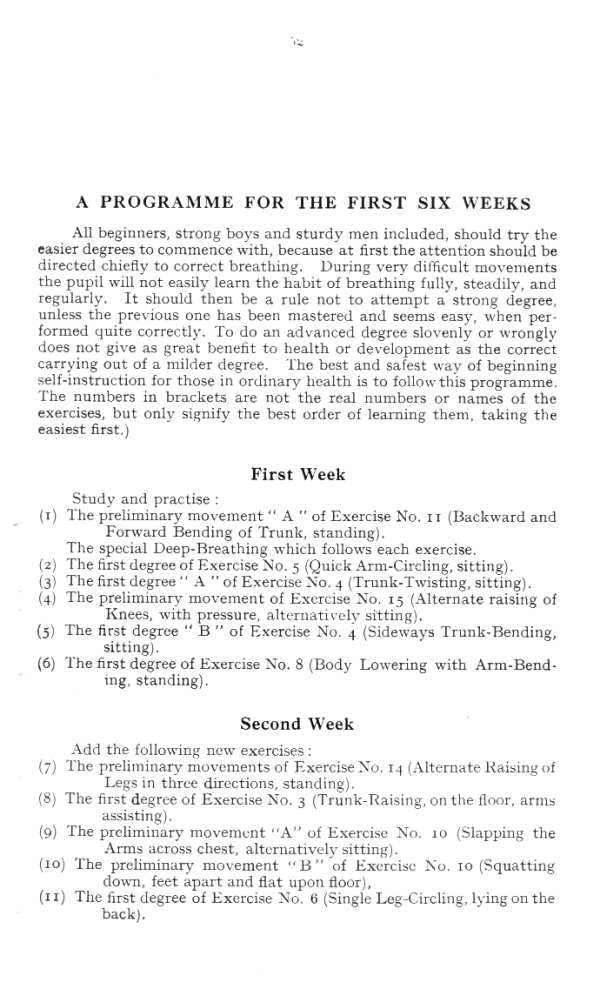72688 system 52

A PROGRAMME FOR THE FIRST SIX WEEKS
AU beginners, strong boys and sturdy men included, should try the easier degrees to commence with, because at ńrst the attention should be directed chieffy to correct breathing. During very dilTicult movements the pupil will not easily learn the habit of breathing fully, steadily, and regularly. It should then be a rule not to attempt a strong degree. unless the previous one has been mastered and seems easy, when per-formed quite correctly. To do an advanced degree slovenly or wrongly does not give as great beneńt to health or development as the correct carrying out of a rnilder degree. The best and safest way of beginning self-instruction for those in ordinary health is to follow this programme The numbers in brackets are not the real numbeis or names of the exercises, but only signify the best order of leaming them, taking the easiest first.)
First Week
Study and practise :
(1) The preliminary moeement " A " of Exercise No. u (Backward and
Forward Bending of Trunk, standing).
The special Deep-Rreathing which follows each exercise.
(2) The first degree of Exercise No. 5 (Quick Arm-Circling, sitting).
(3) Tlie first degree " A " of Exercise No. 4 (Trunk-Twisting, sitting).
(4) The preliminary movement of Excrcise No. 15 (Alternate raising of
Knees, with pressure. alternatieely sitting).
(5) The first degree " B ” of Exercisc No. 4 (Sideways Trunk-Bending,
sitting).
(6) The first degree of Exercise No. 8 (Body Lowering with Arm-Bend-
ing. standing).
Second Week
Add the following ncw exercises:
(7) The preliminary movementsof F.xerciseN'o. 14 (Alternate Raising of
Legs in thre-e directions, standing).
(8) The first degree of Exercise No. 3 (Trunk-Raising, on the lloor. arms
assisting).
(9) The preliminary movemcnt "A” of Exercise No. 10 (Slapping the
Arms across chest, alternatively sitting).
(xo) The preliminary movement "B" of Exercise No. 10 (Sąuatting down, feet apart and fiat upon floor),
(11) The first degree of Excrcise No. 6 (Single Leg-Circling. lying on the back).
Wyszukiwarka
Podobne podstrony:
f1 1 . < Netscape - [Java: Programming for the Internet] File Edit View Go Bookmarks Options Dir
f2 1 J~< Netscape - [Java: Programming for the Internet] File Edit View Go Bookmarks Options Dire
UNIT 6THE SKELETAL SYSTEM The skeletal system provides a framework for the body and protects the vit
18ccw05 Netscape - [Java(tm) - Programming for the Internet] £ile Edit View Co Bookmarks Options Dir
18ccw05 Netscape - [Java(tm) - Programming for the Internet] £ile Edit View Co Bookmarks Options Dir
The programs included with the Debian GNU/Linux system are free software; the exact distribution ter
image033 * Then I saw a new heaven and a new earth: for ttie first heaven and the first earth had pa
00444 )a588943785e7aaa29215489e95475a A Graphical Aid for Analyzing Autocorrelated Dynamical System
Summary PhD thesis presents analysis of RCM maintenance system implementation for the semi submersib
PROGRAM ROZWOJOWY^1 POLITECHNIKI WARSZAWSKIEJ Only for the linear case (no magnetic saturation) the
mbs 027 MY BREATHING SYSTEM sucked in. For persons who lind it very difficult to acquire tłiis contr
więcej podobnych podstron